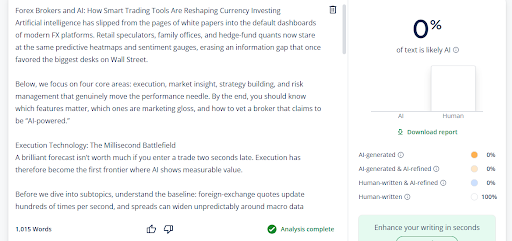
Forex Brokers and AI: How Smart Trading Tools Are Reshaping Currency Investing

July 29, 2025 (Investorideas.com Newswire) Artificial intelligence has slipped from the pages of white papers into the default dashboards of modern FX platforms. Retail speculators, family offices, and hedge-fund quants now stare at the same predictive heatmaps and sentiment gauges, erasing an information gap that once favored the biggest desks on Wall Street.
Below, we focus on four core areas: execution, market insight, strategy building, and risk management that genuinely move the performance needle. By the end, you should know which features matter, which ones are marketing gloss, and how to vet a broker that claims to be "AI-powered."

Execution Technology: The Millisecond Battlefield
A brilliant forecast isn't worth much if you enter a trade two seconds late. Execution has therefore become the first frontier where AI shows measurable value.
Before we dive into subtopics, understand the baseline: foreign-exchange quotes update hundreds of times per second, and spreads can widen unpredictably around macro data drops. AI-enhanced routing engines now watch every micro-movement and decide, in real time, which liquidity provider offers the best fill.
Transparent Smart Order Routing
Traditional order routers looked like black boxes; you sent a ticket in and hoped for the best. New AI routers expose a summary of their decision tree, why they picked LP-A over LP-B, how they weighed latency, and whether they split your order. That transparency lets you diagnose slippage instead of guessing an essential feature when choosing Forex brokers that leverage AI for superior execution.
Latency Prediction Models
Instead of reacting to latency, brokers feed historical network data into gradient-boosting models that forecast spikes milliseconds before they happen. If the model flags congestion in LD4, your order can be redirected to NY4 pre-emptively, protecting spreads during volatile moments such as NFP releases.
AI-Powered Market Insight: From Data Deluge to Actionable Signal
Data is abundant; insight is scarce. The latest broker platforms turn endless news feeds, option flows, and economic calendars into two digestible outputs: sentiment direction and volatility probability.
NLP-Driven Sentiment Scores
Large language models chew through central-bank speeches and real-time headlines, labeling each sentence as hawkish, dovish, or neutral. Moments after a Fed presser, you see a dial that swings green or red, quantifying tone before you finish reading the transcript.
Adaptive Volatility Heatmaps
Clustering algorithms display where orders, stops, and option strikes are stacked on a color-graded grid. You instantly see whether EURUSD's pain points sit at 1.0700 or if the real pressure hides in cross-pairs like EURJPY. Because the map updates every minute, it functions as an early-warning radar for breakout traders.
Democratized Strategy Building: No-Code to Full SDK
The myth that only PhDs can run algos is officially dead. Brokers now tier their toolkits so traders of any skill level can automate an idea.
Drag-and-Drop Builders
If you've ever assembled a PowerPoint slide, you can build a strategy. Select "entry," choose "RSI<30," link it to "buy," and the visual IDE writes the code under the hood. Back-testing runs on server clusters, returning equity curves, Sharpe ratios, and max drawdowns in minutes.
Low-Code Script Editors
Maybe you know basic Python. You can tweak the auto-generated script, swap RSI for a custom momentum formula, and insert a machine-learning filter without rebuilding the wheel. Low-code bridges the gap between hobbyist and professional, letting you refine logic at will.
Raw APIs and SDKs
For prop desks that need granular control, full REST and FIX APIs sit one level deeper. You can pull millisecond-stamped tick data reaching back 14 years, pipe it into your own TensorFlow pipeline, and push orders back through the same socket. The architecture is open; the edge is up to you.
Risk Management Re-Engineered: Guardrails in Real Time
If AI had done nothing else but improve risk controls, regulators would still cheer. Old-school systems ran periodic checks; modern models never sleep.
Continuous Margin Surveillance
Value-at-Risk engines now run on streaming data. The moment your leverage pushes account VaR beyond a predefined percentile, the broker can reduce position size rather than dropping the guillotine of a full liquidation. That soft-landing approach limits emotional blow-ups and protects both sides of the trade.
Monte Carlo Stress Simulations
With GPU acceleration, brokers generate thousands of future price paths in seconds. Toggle the slider to "rate-hike shock" or "emerging-market crisis," and you'll see projected drawdowns, correlation shifts, and capital requirements. It's like taking your portfolio through a wind tunnel before you fly.
Selecting an AI-Savvy Broker: Five Litmus Tests
Textbook features sound great on a product sheet, but how do you verify them in practice?
- Model Transparency. Ask for documentation summarizing the architecture, training data, and validation metrics.
- Execution Metrics. Request a month of filled-order logs; check average latency and slippage.
- Data Accessibility. Confirm you can export both historical and live ticks without paywall traps.
- Regulatory Oversight. Look for Tier-1 licenses (FCA, ASIC, CFTC) that mandate capital buffers.
- Human Support. Ensure a 24/5 dealing desk supplements the bots; tech fails, people recover.
Common Pitfalls and Practical Fixes
Overfitting. If your back-test looks like a ski slope without moguls, increase out-of-sample data and perform walk-forward validation.
Model Drift. Re-train classifiers monthly; markets evolve, and yesterday's features stop working.
Hidden Costs. Some "free" AI toolkits bake fees into spreads or data subscriptions. Do the math before running size.
Overreliance. AI is a probability engine, not a prophecy machine. Marry its signals with macro context and sound money management.
Conclusion: Smarter, Not Easier
AI has not turned currency investing into push-button wealth, but it has redrawn the efficiency frontier. Roughly $7.5 trillion trades hands in forex every day, and participants who integrate machine intelligence handle the flow more nimbly. Early adopters have already reported reductions in slippage of up to 18% and drawdown compression of around 4% compared to legacy methods.
Whether you're trading micro-lots from a home office or steering a multi-asset fund, the mandate is the same: pair human judgment with algorithmic horsepower, demand transparency from your broker, and stay curious. Machines thrive on data; traders thrive on discipline. Put the two together, and the odds tilt a little further in your favor.
Disclaimer/Disclosure: Investorideas.com is a digital publisher of third party sourced news, articles and equity research as well as creates original content, including video, interviews and articles. Original content created by investorideas is protected by copyright laws other than syndication rights. Our site does not make recommendations for purchases or sale of stocks, services or products. Nothing on our sites should be construed as an offer or solicitation to buy or sell products or securities. All investment involves risk and possible loss of investment. This site is currently compensated for news publication and distribution, social media and marketing, content creation and more. Contact each company directly regarding content and press release questions.. More disclaimer info: http://money-liftoff.live/About/Disclaimer.asp%3C/a >. This article is a third party guest post published content and not the content of Investorideas.com . Learn more about posting your articles at http://money-liftoff.live/Advertise/%3C/a >
Please read Investorideas.com privacy policy: https://money-liftoff.live/About/Private_Policy.asp%3C/a >

